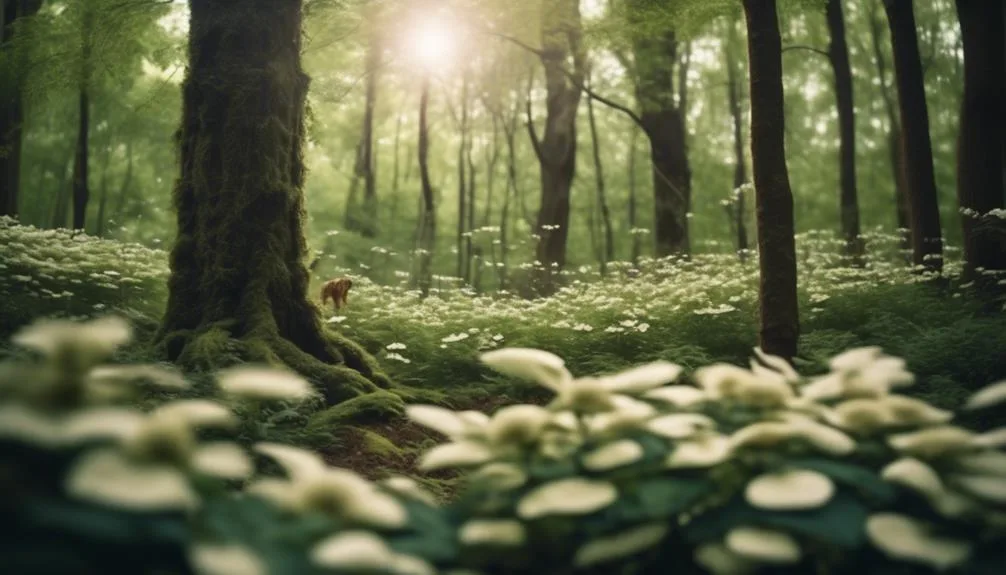As you wander through a forest, you notice the tall trees, the busy wildlife, and the green plants. But have you thought about the role of the delicate dogwood trees in this ecosystem?
These seemingly fragile but strong trees are essential for the forest. They interact with animals and insects, affect the soil and other plants, and have a big impact on the forest's health.
Their relationship with other tree species also adds complexity to the forest.
Role of Dogwood Trees in the Canopy
In a forest ecosystem, dogwood trees play a vital role in the canopy, providing shelter and food for a diverse array of wildlife. Their broad, spreading branches create a dense canopy coverage, offering shade and protection for smaller plants and animals below. Dogwoods also produce berries that are a crucial food source for birds, squirrels, and other woodland creatures.
However, their position in the canopy isn't without challenges. Dogwood trees often face intense competition from other tree species vying for sunlight, nutrients, and space. This competition can influence the overall composition and health of the forest ecosystem, shaping the diversity and distribution of plant and animal life.
Understanding the dynamics of tree species competition in the canopy sheds light on the intricate balance of life within the forest.
Interactions With Wildlife and Insects
Amidst the forest canopy, dogwood trees actively engage with a diverse array of wildlife and insects, shaping the intricate web of interactions within the ecosystem.
Dogwood trees provide essential habitat for a variety of wildlife, including birds and small mammals. Their dense foliage and abundant berries offer shelter and food, supporting biodiversity within the forest.
In addition to serving as a wildlife habitat, dogwood trees play a crucial role in insect pollination. Their beautiful blossoms attract bees, butterflies, and other pollinators, facilitating the reproduction of not only dogwood trees but also numerous other plant species in the forest.
These interactions highlight the interconnectedness of the forest ecosystem, where dogwood trees act as vital contributors to the flourishing wildlife and insect populations.
Impact on Soil and Understory Plants
With their extensive root systems and nutrient-rich leaf litter, dogwood trees significantly influence the soil composition and understory plant growth in the forest ecosystem. The decaying leaves of dogwood trees contribute to the soil fertility, enriching it with essential nutrients and organic matter. This creates a favorable environment for the growth of various understory plants, fostering a diverse and vibrant plant community.
However, the dense shade cast by dogwood trees can also lead to intense competition among understory plants for sunlight, affecting their distribution and abundance. Some species may thrive in this competitive environment, while others may struggle to survive.
Understanding the intricate dynamics between dogwood trees and the understory plants is crucial for managing forest ecosystems and maintaining a healthy balance of plant species.
Contribution to Biodiversity and Ecosystem Health
Nurturing a diverse array of plant and animal species, dogwood trees play a crucial role in enhancing the overall biodiversity and promoting the health of the forest ecosystem. They contribute to the ecosystem in various ways:
- Pollinator Attraction, Habitat Creation: Dogwood trees provide nectar, pollen, and shelter, attracting a wide range of pollinators such as bees and butterflies. This not only aids in the reproduction of dogwood trees but also supports the overall health of the forest by facilitating the reproduction of other plant species.
- Nutrient Cycling, Soil Health: As dogwood trees shed their leaves, they contribute organic matter to the forest floor, promoting nutrient cycling and enhancing soil health. This process supports the growth of understory plants and provides a rich, fertile environment for a multitude of organisms.
Dogwood trees truly serve as vital contributors to the intricate web of life within the forest ecosystem.
Relationship With Other Tree Species
Dogwood trees, as they interact with other tree species in the forest, create a complex network of relationships that impacts the overall dynamics of the ecosystem.
In the forest, competition for resources such as sunlight, water, and nutrients is common among tree species. Dogwood trees, with their understory growth habit, often compete for light with taller tree species.
However, they also engage in symbiotic relationships, particularly with mycorrhizal fungi. These fungi form mutually beneficial associations with dogwood tree roots, aiding in nutrient absorption and providing a competitive advantage.
Moreover, dogwood trees can play a crucial role in supporting the health of other tree species by attracting beneficial insects or birds that aid in pollination and pest control.
Ultimately, the relationships between dogwood trees and other species contribute to the intricate balance of the forest ecosystem.
Conclusion
In the delicate balance of the forest, dogwood trees stand as essential contributors, providing shelter, sustenance, and enriching biodiversity.
Their role in creating a healthy ecosystem resonates throughout the intricate web of life, leaving us to ponder the interconnectedness of nature.

My interest in trees started when I first saw the giant sequoias in Yosemite.
I was a teenager then, and I remember thinking, “I need to learn more about this.”
That moment stuck with me.
A few years later, I went on to study forestry at Michigan Tech.
Since graduating, I’ve worked in a mix of hands-on tree care and community education.
I’ve spent over ten years helping people understand how to plant, maintain, and protect the trees in their neighborhoods.
I don’t see trees as just part of the landscape.
They are living things that make a real difference in our daily lives.
